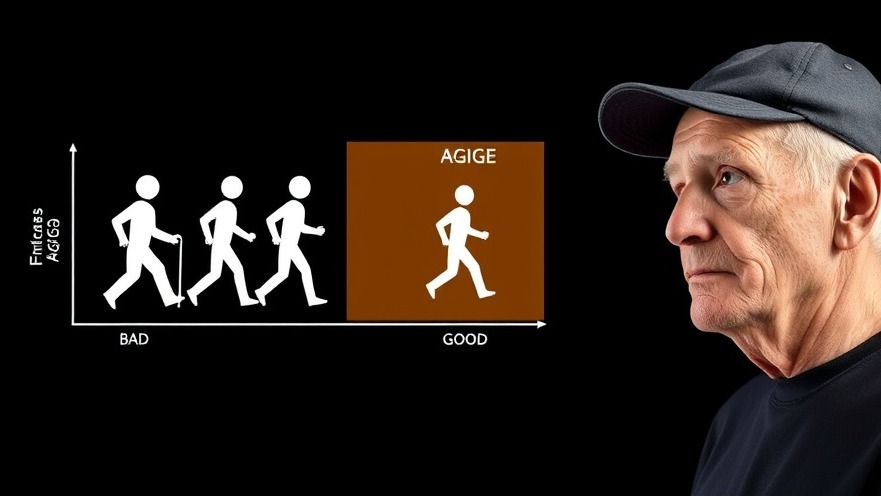
Unlocking Longevity: Three Simple Tests for a Healthier Future
As the pursuit of longevity becomes increasingly significant, understanding how fitness impacts our lifespan offers vital insight. In the latest findings regarding functional fitness, three simple tests can provide a clearer picture of our longevity potential. These tests not only assess our physical capabilities but also guide us on how to enhance our overall well-being. Here’s how you can get started today!
In 'These 3 Tests Predict Longevity Better Than Everything Else', the video discusses crucial fitness tests for assessing longevity, prompting a deeper analysis of how these insights can empower us.
The Gate Speed Test: A Walk Toward Health
The first test we’ll delve into is the gate speed test. Backed by a meta-analysis in the Journal of the American Medical Association, this test measures how fast you can walk six meters. Surprisingly, your walking speed is just as telling as traditional health metrics like blood pressure. To perform the test, find a flat space, measure a distance of six meters, and have a friend time you as you walk briskly. Calculate your speed—aim for over 2 meters per second for optimal health!
But why does walking speed correlate so strongly with longevity? The answer lies in what it reflects: muscle function, blood flow, and even cognitive health are all underlying factors that influence how quickly we can navigate our environment. To improve your gate speed, aim for 30 minutes of walking each day and pay attention to your foot mechanics. Functional shoes that support your natural gait can significantly contribute to your overall fitness.
Mastering Your Balance: The Single Leg Test
Now let’s take it a step further with the single leg balance test. A study published in the British Journal of Sports Medicine revealed that individuals who can’t hold a balance on one leg for 10 seconds have almost double the usual risk of premature death. This test emphasizes the importance of balance as a component of overall health.
To conduct the test, simply stand on one leg with your arms at your sides for 10 seconds. Switch legs and repeat! If this proves challenging, don’t be disheartened—practice makes perfect. Improving your balance can be as easy as incorporating activities like yoga or tai chi, which can also enhance proprioception and coordination, crucial elements in preventing falls as we age.
Grounded in Mobility: The Sit and Rise Test
Finally, the sit and rise test gauges a vital aspect of mobility that often goes unnoticed. The ability to transition between sitting and standing without using hands reflects strength and flexibility. This capability is closely linked with survivability in older adults, as identified in a study from the European Journal of Preventive Cardiology.
To execute this test, get into a comfortable space, sit down on the ground, and then rise back to a standing position using minimal assistance from your hands. The more adept you are at this movement, the better your current mobility and the less likely you are to experience health issues later. Practicing sitting and standing from the floor regularly will greatly enhance your functionality!
Actionable Insights for Longevity
Incorporating these tests into your weekly routine offers a proactive path to health. Consider engaging in a balanced approach that includes:
Regular Walking: Commit to at least 30 minutes a day, which studies show can significantly reduce the risk of chronic illnesses.
Balance Exercises: Making balance practice a fun routine through activities like dance or martial arts
Floor Mobility: Integrating floor sitting into your daily relaxation practices
Each of these practices can infuse your daily routine with vitality while fostering resilience in your body and mind.
Fostering a Culture of Longevity
Sharing these insights with friends and loved ones can create a supportive community focused on improving health. Engaging with others as you work on these tests fosters encouragement and accountability. Consider incorporating gentle walking clubs or balance training sessions into your social activities, transforming health improvement into a shared experience.
Conclusion: Shape Your Future
The journey to a longer and healthier life can begin with simple steps taken today. These three tests not only enhance your physical capabilities—but also ensure that you’re stacking the odds in your favor for future health. Over time, staying active while being aware of the functional aspects of your body can lead to profound improvements in longevity.
By integrating the gate speed test, single leg balance test, and sit-and-rise test into your life, you're empowered to transcend traditional health assessments. You can enrich your life quality and longevity—all while enjoying your journey.
Now’s the time to take action! Reflect on your results and set personal goals for improvement. What steps will you take to ensure a longer, healthier life? Start planning today!
 Add Row
Add Row  Add
Add 




Write A Comment